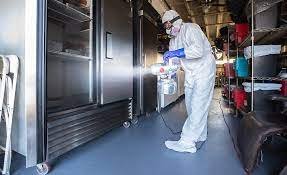The forecasted market size for antimicrobial coatings worldwide was $3.7 billion in 2020 and is expected to increase to $11.0 billion by 2030, rising at a CAGR of 11.5% between 2021 and 2030.
COVIDIMPACTSTATEMENT
Antimicrobial coatings are a type of coating that include particular chemicals intended to stop the growth of bacteria and other diseases by rupturing cell membranes. These coatings enhance corrosion resistance, surface durability, and aesthetics in addition to their role of suppressing microbial proliferation.
Antimicrobial coatings are essential to the healthcare sector. Healthcare-associated infections are a common danger for healthcare facilities (HAIs). In healthcare facilities, antimicrobial coatings reduce the risk of infection and the spread of microorganisms and germs that are typically found on high-touch surfaces like switches and doorknobs. In order to reduce the danger of infection transmission, antimicrobial coatings are also utilized on catheters, surgical tools, medical equipment & trays, and medical gadgets. For reducing the danger of infections related to healthcare, further examples include medical fabrics, gloves, surgical masks, bandages, and woven and non-woven hospital textiles. Antimicrobial coatings are increasingly in demand due to technical improvement and the ability to employ them on medical implants. For instance, the European Centre for Disease Prevention and Control reports that more than 4 million people each year contract HAIs, which ultimately results in 37,000 fatalities. Using antibiotics and disinfectants properly helps to prevent this. However, the risk of HAI is reduced by the use of antimicrobial coatings on medical equipment and surfaces. In the healthcare sector, antimicrobial coatings are seen as a useful and promising strategy against bacterial development. All of these elements work together to increase demand for antimicrobial coatings, which boosts the expansion of the global market.
Antimicrobial coatings do, however, come with a number of dangers, including the release of hazardous pollutants into the environment and active ingredient emissions. Antimicrobial coatings frequently produce active substances that slowly seep into the environment, posing a health risk. Moreover, antimicrobial coatings made of silver, zinc, and copper have a propensity to emit poisons harmful to marine life including fish and crabs. Antimicrobial coatings raise the risk of the growth of adaptable microorganisms and drug-resistant bacteria by emitting active-nano components and causing delayed infusion.
On the other hand, the ships and equipment used in cargo and passenger ships are constantly exposed to extreme maritime conditions such excessive salinity. This therefore enhances the propensity for microbial development, including the growth of bacteria and algae, which causes biofouling of these objects and their associated machinery. Due to bio corrosion, biofouling increases frictional resistance, reduces equipment shelf life, and raises ship fuel consumption. In conjunction with favorable marine circumstances, bacteria and microorganisms have a tendency to colonize items manufactured by humans more quickly. A small colony of bacteria and microorganisms causes the development of a bio-film on the surface of ships, which in turn causes the parts to deteriorate and cause promoted bio corrosion. Antimicrobial coatings are expected to provide a new market growth potential by preventing bio corrosion that has been promoted.
Type, end-use industry, and region are the segments used to divide the antimicrobial coatings market. The market is divided according to type into silver-based, zinc-based, copper-based, polymer-based, and other categories. It is divided into the following categories based on end-use industry: healthcare, building & construction, food service packaging, aviation, marine, and others. North America, Europe, Asia-Pacific, and LAMEA are all covered in terms of regions for this market study.
Included among the significant businesses highlighted in this study are Advanced Nanotech Lab (ANT Lab), Novapura AG, Axalta Coating Systems, LLC, Apogee Enterprises Inc., Akzo Nobel N.V., Sciessent LLC, Pylon Coatings, PPG Industries, Inc., The Sherwin Williams Company, and Nippon Paint Holdings.
Antimicrobial Coatings Market, By Region
In 2020, the antimicrobial coatings market in Europe held 38.6% of the market share. During the forecast period, this market is expected to grow at the highest CAGR of 12.4%. The expense of treating patients for bacterial infections and the number of infections-related deaths have increased as a result of the transmission of bacteria through medical equipment. As a result, many technologies and goods are employed and implemented to reduce the frequency of illnesses linked to medical devices. By using hydrophilic polymeric antimicrobial surface coatings, device surfaces can be modified to reduce the danger of microbe and bacterial adhesion. Antimicrobial coatings made of polymers are intended to provide non-fouling properties on the applied surface and reduce pathogen protein adsorption, which in turn reduces microbial adhesion.
Antimicrobial coatings market, by type
The copper-based kind, which generated the most revenue in 2020, is expected to expand at a CAGR of 11.2% over the course of the projection period. The global public health is significantly impacted by healthcare associated infections (HAI). Spontaneous instances of HAIs are primarily caused by contaminated surfaces in hospitals and healthcare facilities. The main market trend is the use of copper-based antimicrobial coatings, which are efficient and capable of decreasing microbial growth on high-touch surfaces in the healthcare industry.
Antimicrobial coatings market, by end-use industry
The healthcare end-use industry, which dominated the global market in 2020, is expected to expand at a CAGR of 12.0% over the course of the forecast period. Usage of antimicrobial coatings in the healthcare industry decreases the incidence of healthcare associated infections (HAIs). Examples of bacteria and viruses that frequently raise the risk of HAIs include MRSA, E. coli, and VRE. Even after repeated contamination and usage, antimicrobial coated items have the tendency to reduce the growth of bacteria and viruses in hospital facilities, patient rooms, medical equipment, and PPE kits. Antimicrobial coatings are used on items including surgical drapes, medical curtains, shelving units, dental trays, medicine dispenser units, hospital beds, healthcare footwear, and furniture to reduce the risk of HAIs and maintain a healthy atmosphere that is essential for patient recovery.
Key Market Segments
BY TYPE
- Silver-based
- Zinc-based
- Copper-based
- Polymer-based
- Others
BY END-USE INDUSTRY
- Healthcare
- Building and construction
- Food service packaging
- Aviation
- Marine
- Others
BY REGION
- North America
- US
- Canada
- Mexico
- Europe
- Germany
- France
- Italy
- Spain
- UK
- Russia
- Rest of Europe
- Asia-Pacific
- China
- India
- Indonesia
- Myanmar
- Malaysia
- Thailand
- Japan
- South Korea
- Australia
- Rest of Asia-Pacific
- LAMEA
- Brazil
- Saudi Arabia
- South Africa
- UAE
- Rest of LAMEA
Key Market Players
- ADVANCED NANOTECH LAB (ANT LAB)
- AKZO NOBEL N.V.
- APOGEE ENTERPRISES, INC
- .AXALTA COATING SYSTEMS, LLC
- NIPPON PAINT HOLDINGS
- NOVAPURA AG
- PPG INDUSTRIES, INC.
- PYLON COATINGS
- SCIESSENT LLC
- THE SHERWIN-WILLIAMS COMPANY



